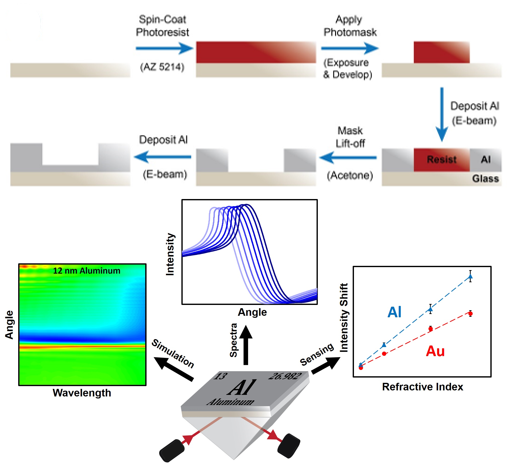Aluminum Microchips for Biosensing and Pathogen Identification
Background
Label-free technologies such as surface plasmon resonance (SPR) spectroscopy form a core component of bioanalytical and biopharmaceutical research. SPR also plays a key role in DNA sensors and for disease diagnosis. Plasmonic film used in manufacturing sensor substrates for these analyses has been limited to gold. While there are other materials with excellent plasmonic properties, little work with demonstrated practical prototypes exists that take advantage of this potential.
Brief Description
Prof. Quan Cheng and colleagues from the University of California, Riverside have developed aluminum (Al) microchips for highly sensitive SPR detection of bioanalytical targets. This technology allows for determination of binding kinetics of drug targets and disease marker detection. In addition to applications for SPR, these Al microchips enable other surface-based techniques such as enhanced Raman spectroscopy and MALDI-MS for direct pathogen identification.
Compared to traditional gold substrates, Al has a broad range of advantages. It is more plasmonically active, leading to high optical sensitivity, and it is chemically flexible for design of various analytical platforms. Al also has several manufacturing benefits that make it commercially appealing when compared to gold, such as higher abundance, lower cost, and simple integration into existing manufacturing processes such as CMOS.

Fig 1: (Top) Fabrication of aluminum microchips. (Bottom) Aluminum demonstrates a high theoretical and practical plasmonic activity correlating to a higher detection sensitivity for biological targets.
Applications
- For use as a microchip for biopharmaceutical study of molecular interactions compatible with industry standard instrumentation
- For use as a microchip in biosensing techniques for food safety and disease diagnosis
Patent Status
| Country | Type | Number | Dated | Case |
| United States Of America | Published Application | 2022039753 | 12/15/2022 | 2021-827 |
Related Materials
Contact
- Grace Yee
- grace.yee@ucr.edu
- tel: View Phone Number.
Other Information
Keywords
microchip, aluminum, surface plasmon resonance, SPR, MALDI-MS, laser desorption ionization mass spectrometry, LDI-MS
